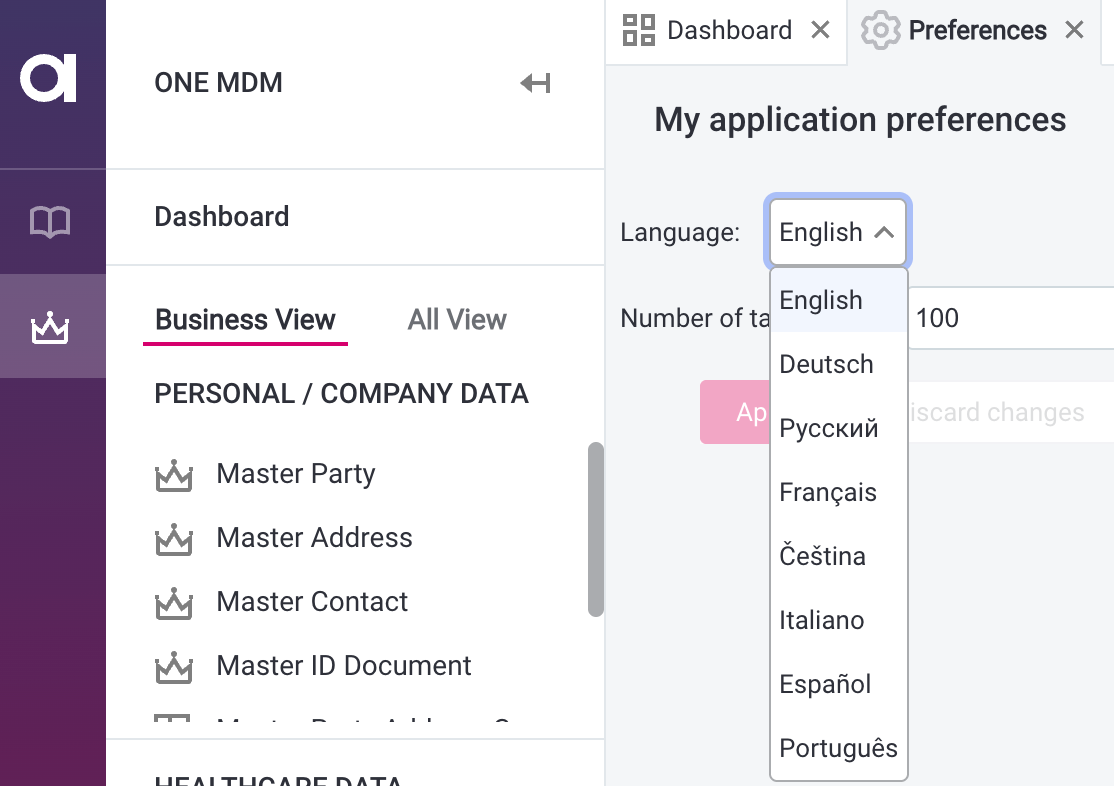Ataccama 16.2.0 Release Notes
Products |
|
|---|---|
Release date |
|
Downloads |
|
Security updates |
Known Issues
| This section lists issues we are currently aware of which are considered significant, and which could impact the functionality of your build. We highly recommend reviewing this section before every upgrade. |
| Module | Issue | To be resolved in |
|---|---|---|
ONE |
Notifications from ONE to MS Teams are currently unavailable due to changes in the MS Teams platform. Microsoft has replaced Office 365 connectors with the new Workflows app, requiring updates to the existing integration. |
16.3.0 |
ONE |
ONE-75706: After upgrading to or deploying version 16.2.0, ONE may sometimes remain in Maintenance mode. This issue occurs when upgrade steps fail due to a conflict caused by them running simultaneously with an SQL query from the PostgreSQL exporter. To work around this issue, manually run the failed upgrade steps:
For more information on working with system changes, see System Changes. |
16.2.0-patch1 |
ONE |
Applying rules or terms to the technical attributes of ONE Data tables ( |
16.3.0 |
ONE
Improvements to Monitoring Projects
Validation for Attribute Filters
Attribute filters in monitoring projects now validate filter complexity upfront to limit the number of possible value combinations. This prevents monitoring project failures due to processing limits, saving you processing time.
Filter validation checks the number of distinct values in a given attribute:
-
<100 values: The attribute can be safely used as a filter.
-
100-20 000 values: The attribute can be used as a filter, but you are warned that there is an increased risk of DQ monitoring failure.
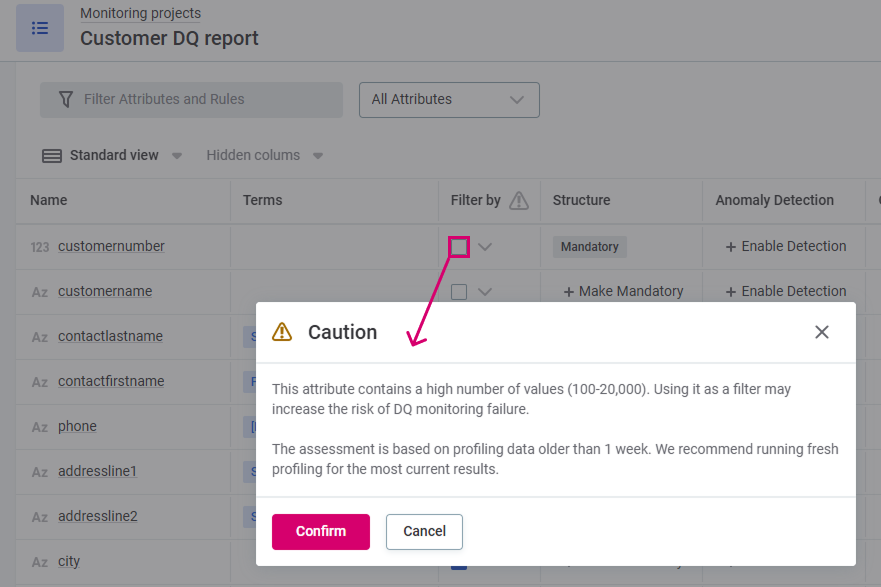
-
>20 000 values: The attribute cannot be used as a filter.
Refined Rule Instance Notification Thresholds
We have refined how rule instance notifications work in monitoring projects.
Previously, a warning was sent (and a DQ issue reported) when the data quality result for a rule instance was less than or equal to the specified threshold. Now, a warning is triggered only when the result falls strictly below the threshold, providing more precise control over notification sensitivity.
For example, if you set the threshold to 100%, you are now notified of any result that falls below that value, even by a small amount.
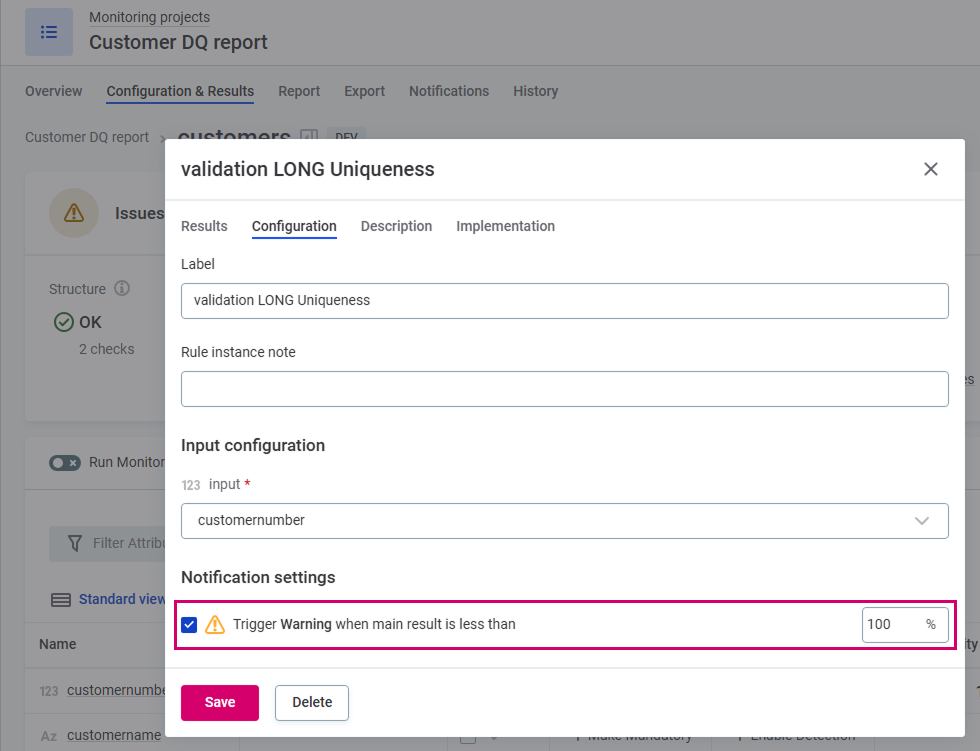
Since the logic for triggering warnings has changed, you might want to review and adjust your thresholds after upgrading to ensure they still align with your data quality expectations.
Improvements to Lineage
AI-Powered Data Transformation Explanations
Use AI to translate SQL queries into clear, natural language explanations directly within the Transformation context panel in lineage diagrams. This makes it easier to understand complex data transformation logic and attribute origins—no deep SQL expertise required.
With more accessible data lineage, you can interpret transformation steps faster and more accurately, improving both productivity and troubleshooting efficiency. Just look for the star icon to view AI-generated summaries.
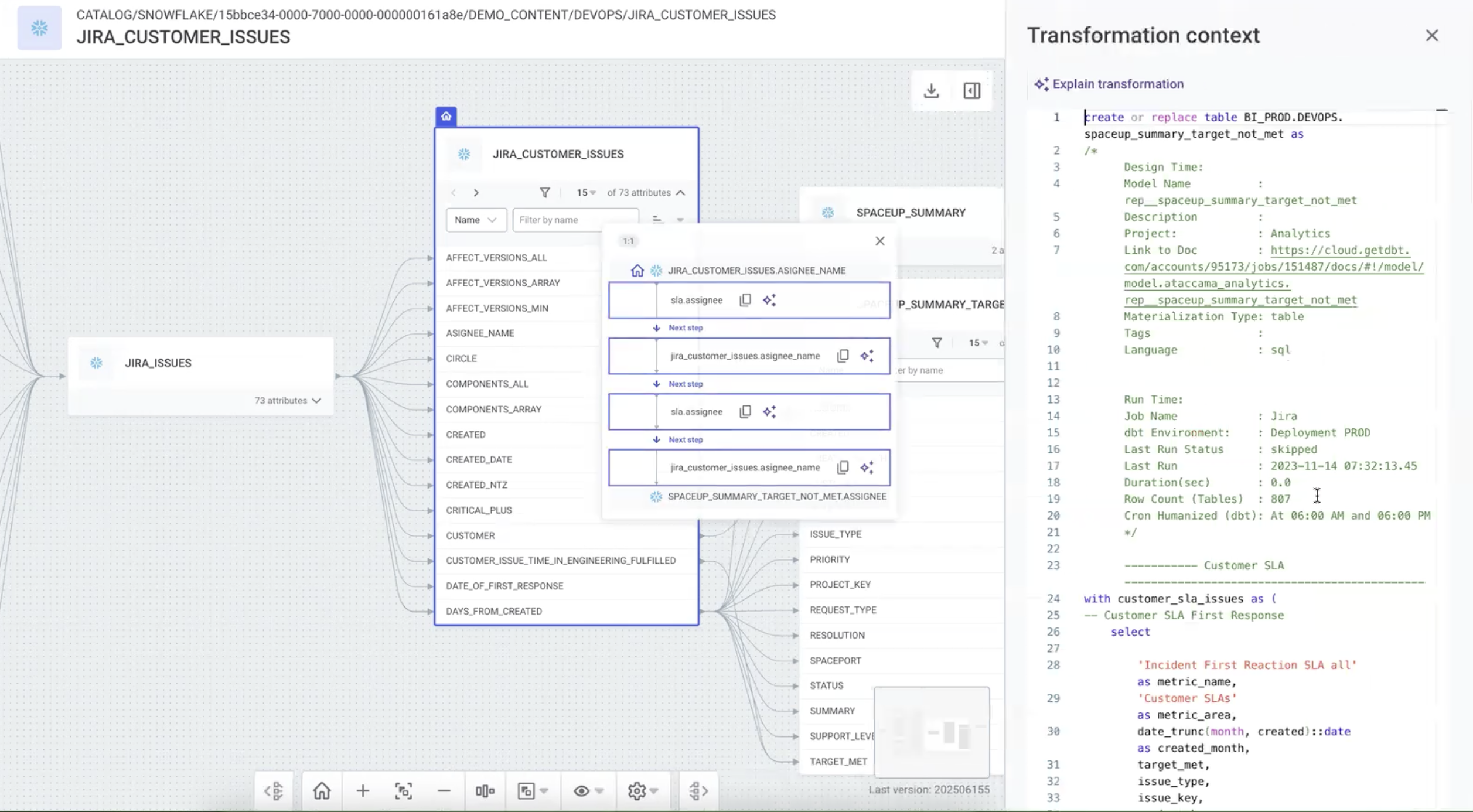
For more information, see Explain SQL transformations in lineage.
Edge Processing in Lineage
With Ataccama Lineage edge processing, you can scan lineage information from sources that cannot be accessed directly from your cloud environment. This bridges the gap between standalone lineage scanners and full platform integration that the built-in scanners provide.
Edge scanners operate as local instances that receive scan workloads from the cloud, process them close to your restricted data sources, and seamlessly deliver results back to the platform, all without manual intervention. You retain centralized control over scan plans, result imports, and other management tasks through the Ataccama ONE Platform, while the actual scanning happens locally where your data resides, ensuring you can easily comply with your organization’s security regulations.
To get started, install one or more edge instances of the standalone lineage scanner and register them with your cloud-based Lineage service. For details, see Lineage Edge Processing.
Support for Azure Key Vault
Lineage scanners can now connect to Azure Key Vault during scanning, allowing you to use AKV value references like @@ref:akv:[*] in your scan plans.
Now you can configure these connections when you need them, so that sensitive values stored in Azure Key Vault are automatically retrieved when running scans.
With the standalone scanner, the connection is configured through the command line (see Configure Azure Key Vault). With built-in lineage scanners, you can set up a connection from the Knowledge Catalog > Scan plans screen. To get started, select the key icon and provide the information required.
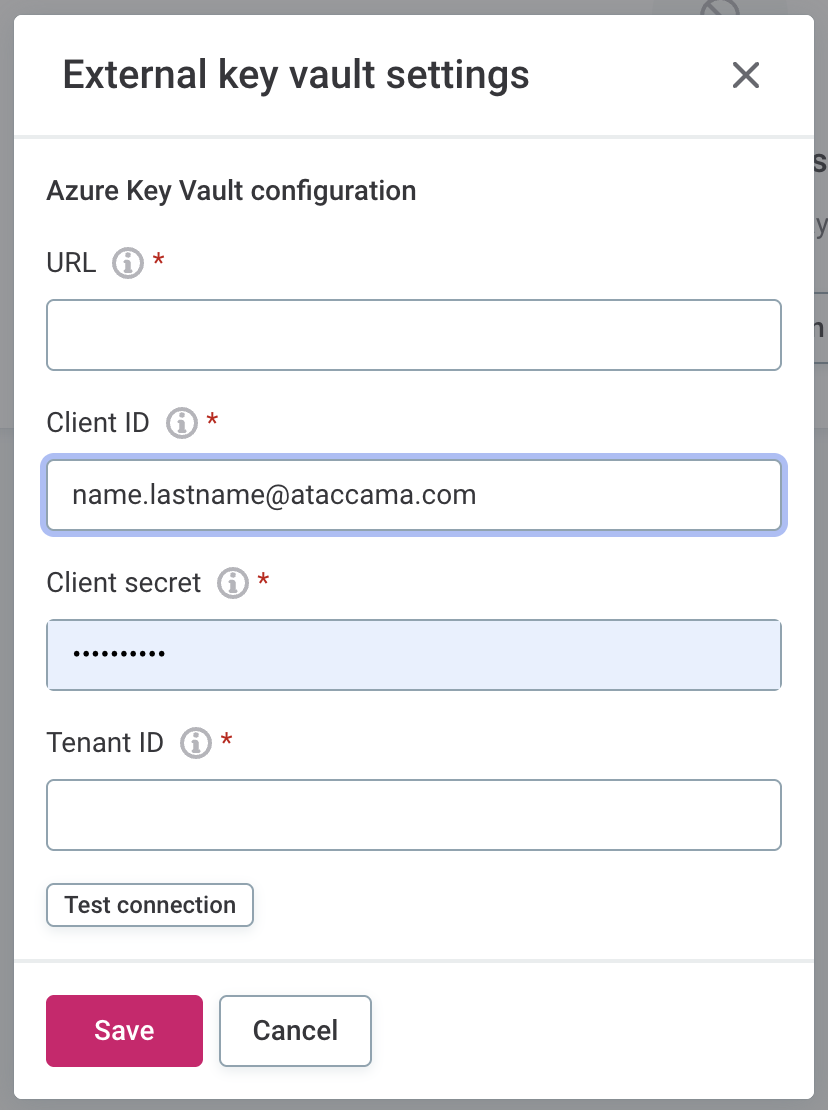
Readability Enhancements in Lineage Diagram: Compact View and Grouped Diagrams
To improve diagram readability in complex data landscapes, the lineage diagram now features:
- Compact Data Store view
-
A simplified view for displaying only essential information for each catalog item, letting you see more items at once. Switch between standard and compact views using the eye icon in the diagram toolbar.

- Grouped diagrams
-
Large remain collapsed until you select specific assets for analysis, allowing you to drill down as needed. When you select an attribute, the diagram expands to show only relevant attributes in the chosen dataflow.
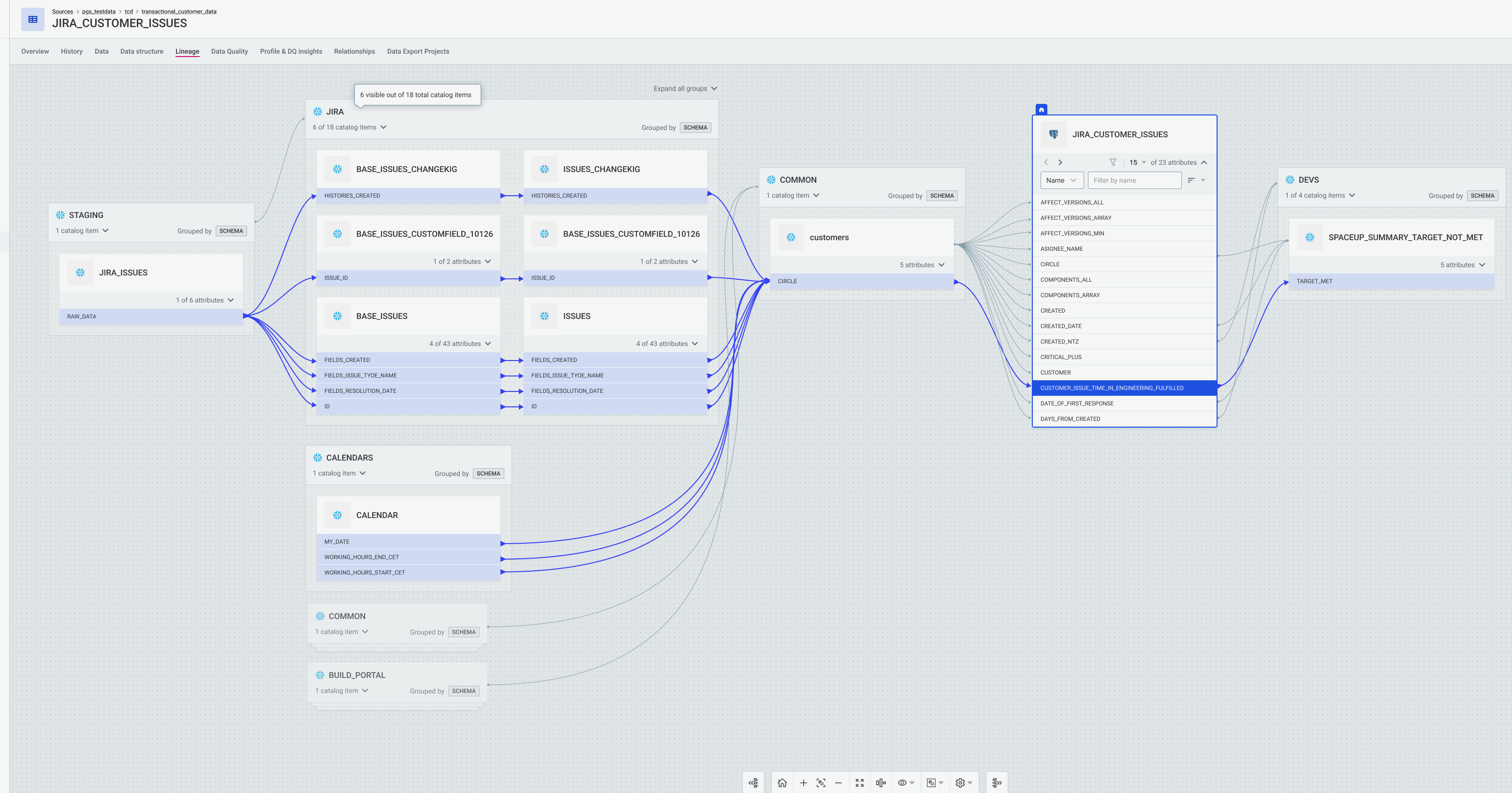
Both updates reduce visual clutter while preserving complete analysis capabilities.
Add Context with Rule Instance Notes
You can now add a note to each rule instance after applying a rule to an attribute.
Use this field to capture additional context or details—such as examples, clarifications, or justifications—for that specific rule instance. These notes are purely informational and do not impact the overall data quality results.
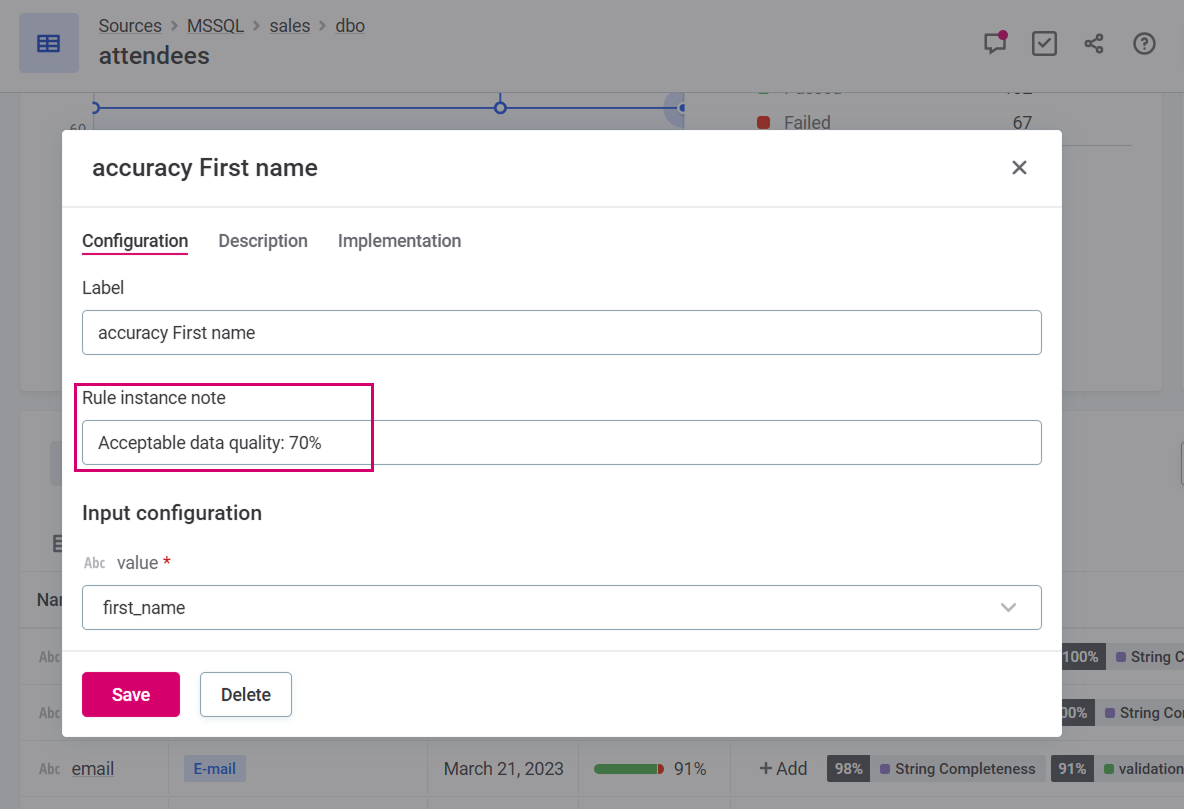
Simplified Credentials Management for Data Sources
Credentials management is now simpler with a unified label-based system that replaces multiple credentials collections.
The new system lets you assign distinct credentials for interactive use and automated tasks, ensuring your scheduled workflows continue running even when SSO-based credentials expire.
For more information, see Connect to a Source > Credentials.
| If you are upgrading to 16.2.0, you are automatically updated to the new system and no action is needed. |
Automatic Synchronization of Tableau Reports
When Tableau workbooks or projects are moved or renamed, the corresponding Tableau reports in ONE are automatically updated. In earlier versions, this used to create report duplicates.
This provides several advantages:
-
Eliminates duplicate dashboards in the Data Catalog.
-
Maintains historical metadata and lineage information.
-
Minimizes manual effort needed to identify and clean up the outdated entries.
As a result, you get a cleaner, more reliable data environment and simplified report management.
To support this transition, we recommend removing any existing duplicate Tableau reports from ONE before proceeding with the upgrade.
Proxy Server Support for Power BI, Power BI Report Server, and Tableau in Hybrid Setups
If you are running Data Processing Engine (DPE) in hybrid mode, you can specify an HTTP proxy server to connect to Power BI, Power BI Report Server, and Tableau sources.
To do this, provide the connection details as environment variables or in the DPE configuration. To learn more, refer to the following articles depending on the source:
Arrow Flight SQL Support for Dremio
Dremio connections now support the new Arrow Flight SQL JDBC driver, offering faster performance compared to the legacy driver.
The new driver is automatically replaced in existing connections after upgrade. For information about the required configuration in Dremio, see DQ&C 16.2.0 Upgrade Notes.
Orchestration Server Restart in Cloud Environments
You now have more control over when and how the Orchestration Server updates happen in Ataccama Cloud environments, reducing downtime and applying configuration changes faster.
Using the new Restart server on commit option in the server settings, you can restart the Orchestration Server from the Cloud Portal. This way, new configuration changes are applied automatically, as soon as they are detected.
If your changes affect only workflows, schedules, data files, or similar, the services are reloaded without a full restart, which further minimizes productivity disruptions.
You can also restart the server on demand from the Admin Center > Server Health Status tab.
To learn more, see Orchestration Server in Ataccama Cloud.

Updates in the Left Navigation Menu
The left navigation menu now features updated icons and improved organization to make common tasks easier to find.
Support for Portuguese Language
You can now change the language of the application to Brazilian Portuguese.
For details, see Change language.
Keycloak Upgrade Requires User Attributes
Version 16.2.0 upgrades to a new Keycloak version that requires all user accounts to have email address, first name, and last name populated to ensure reliable authentication.
Before upgrading, verify all Keycloak users have these attributes configured, particularly service users used by runtime servers. For more information, see DQ&C 16.2.0 Upgrade Notes.
MDM
Activate and Deactivate Records in Mixed Style
In the mixed implementation style, where records can be authored directly on the master layer, combined records can now be activated or deactivated from the MDM Web Application.
Deactivation is used to label certain records as inactive, allowing you to preserve existing data while excluding it from active operations. Previously, this option was available only for consolidated records, for which input is loaded from a centralized hub.
This extends flexible data lifecycle management to mixed implementations, giving you consistent record state control across all deployment styles without losing valuable historical information.
In addition, Set override > Deactivate and Set override > Deactivate actions in the web application are now called Activate and Deactivate respectively.
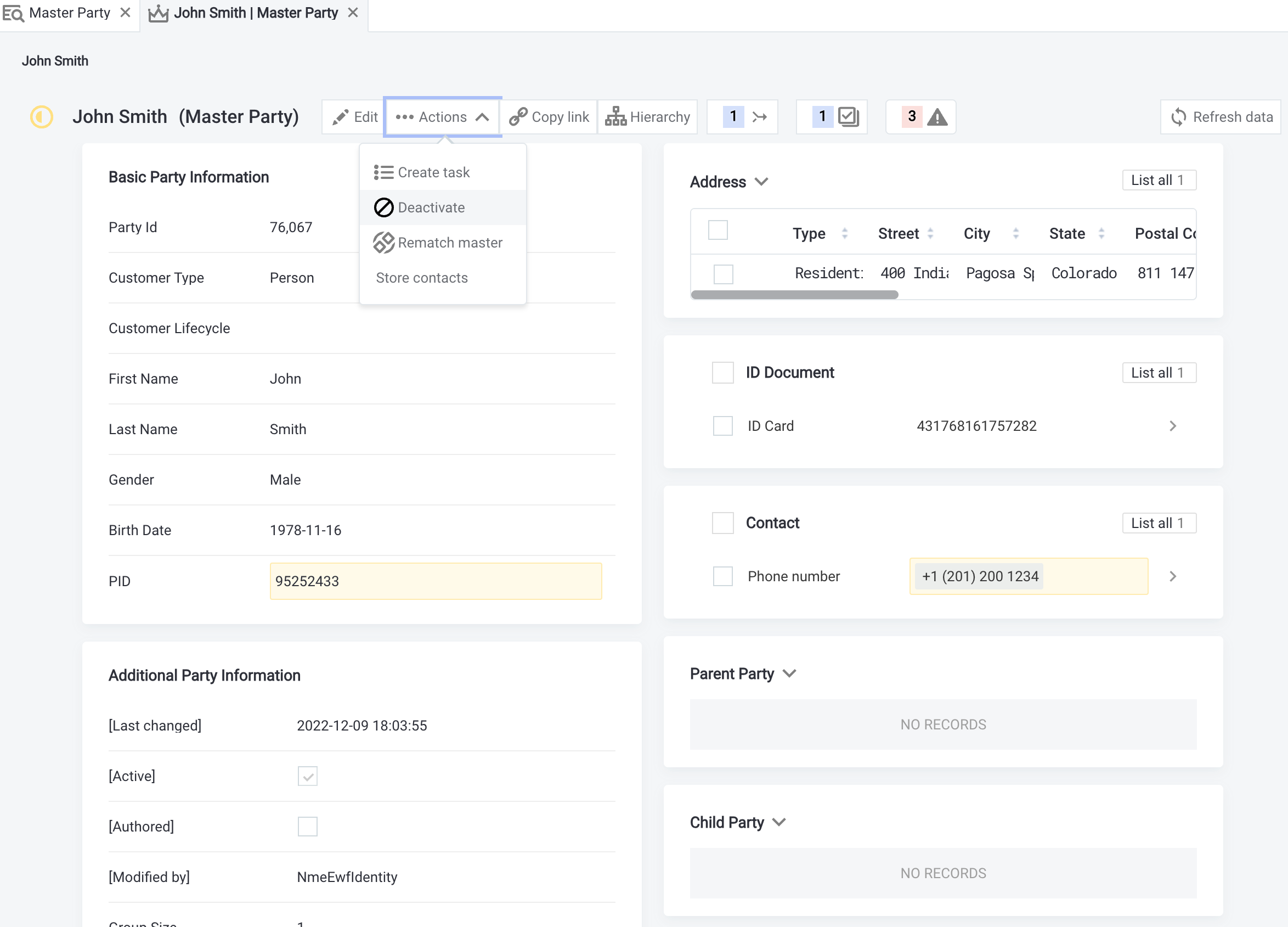
Enhanced REST API Permission Controls
In MDM REST API, you can now restrict which users can create which records. This ensures users can only create the data they’re authorized to modify, preventing unauthorized record creation through API endpoints.
The following permissions were added:
-
WriteInstanceLayer- Allows creating instance records. -
WriteMasterLayer- Allows creating master records. This permission can be further limited to specific entities.
In addition, the WriteEntities permission now lets you create both instance and master entities (including entities with master view attributes).
Previously, this was reserved only for creating instance entities.
For more details about how to configure the new security permissions, refer to Security and Audit.
Improvements to MDM Monitoring
We have expanded MDM monitoring capabilities with over 20 new metrics covering data access operations (batch, publishing, services, streaming), startup performance tracking, and user activity monitoring.
Additionally, metric labels have been standardized to camelCase for consistency, while DQ engine threadpool metrics have been consolidated for clearer reporting.
For a summary of changes, see MDM 16.2.0 Upgrade Notes. For a full list of monitoring metrics, see MDM Monitoring Metrics.
Redesigned Documentation Navigation
Our documentation now features a task-oriented navigation structure that aligns with how you actually work, rather than being organized solely by product features and modules.
What’s improved:
-
Task-focused categories that match real user workflows.
-
Consistent section naming for faster browsing and discovery.
-
Enhanced discoverability, helping you find relevant content even without knowing specific feature names.
Whether you’re new to Ataccama or an experienced user, the updated navigation makes finding relevant information faster and more intuitive.
Fixes
ONE
Click here to expand
- 16.2.0-patch11
-
-
ONE-80337: All Gen AI features work as expected. Previously, features such as Chat with documentation and SQL to text would fail with a content validation error.
-
- 16.2.0-patch10
-
-
ONE-80568: Submitting monitoring projects no longer fails when a relevant Data Processing Engine is temporarily disconnected.
-
ONE-80737: Fixed a performance issue in the monitoring projects filter validator that determines suitable attributes for filters.
-
ONE-80798: Monitoring projects on a Snowflake source with no exports or post-processing plans configured no longer get stuck in the postprocessing status.
-
- 16.2.0-patch9
-
-
ONE-80250: All Gen AI features work as expected. Previously, features such as Chat with documentation and SQL to text would fail with a content validation error.
-
- 16.2.0-patch8
-
-
ONE-80151: Fixed a performance issue in the filter validator that determines suitable attributes for monitoring project filters.
-
ONE-79607: Text in Custom Term Property doesn’t overflow adjacent elements.
-
ONE-79298, ONE-79269: Upgraded third-party dependencies in the Task and AI Evolution services for improved security and stability.
-
- 16.2.0-patch6
- 16.2.0-patch5
-
-
ONE-75626: Scheduled monitoring projects do not fail even if the Data Processing Engine (DPE) is temporarily disconnected when the run starts.
-
ONE-79292: Resolved a critical security issue by strengthening password reset controls to prevent unauthorized account access in SSO-enabled Ataccama Cloud environments.
-
ONE-79006: Improved Keycloak master realm resilience in Ataccama Cloud environments, preventing console access and lockout issues.
-
ONE-79174: Upgraded third-party dependencies in DPE for enhanced security and stability.
-
- 16.2.0-patch4
-
-
ONE-78894: Metadata import now handles Microsoft Excel files that contain whitespace in names.
-
ONE-78620: The Task service can be upgraded from 15.4.1 to 16.2.0 without issues.
-
ONE-78358, ONE-78747: Upgraded third-party dependencies in AI services for enhanced security and stability.
-
ONE-78168: Increased the row limit for CSV files in lineage import to 50M rows.
-
ONE-78096: Snowflake lineage scanner now supports using password-encrypted private keys for authentication.
-
ONE-78823: Fixed the issue where running Azure Data Factory lineage scanner would fail with a deserialization error.
-
ONE-75949: Fixed diagram calculation error when importing MANTA lineage from a ZIP file.
-
- 16.2.0-patch3
- 16.2.0-patch2
-
-
ONE-76430: Importing metadata from BigQuery sources is now approximately 30% faster, with the most noticeable improvements when working with large schemas.
-
ONE-77301: In ONE Data, the All DQ Rules option in the attribute filter behaves as expected. When filtering either passed or failed records, you can now view records that failed a specific rule.
-
ONE-77285: Fixed the issue where Spark profiling on a job cluster would fail if using a custom name for Spark jobs.
-
ONE-76999: Fixed the issue with metadata import failing when running it on assets not yet imported into ONE after upgrade.
-
ONE-76104: In Ataccama Cloud environments, importing metadata from SAP S/4HANA sources no longer fails due to missing drivers.
-
ONE-76709: Fixed a deadlock issue in the event queue processing that could cause service interruptions and improved overall system reliability.
-
ONE-76781: When lineage diagram grouping is used, the setting is stored and applied to newly opened diagrams as well.
-
ONE-77240: Improved database logging for faster troubleshooting.
-
ONE-74998: All localization files are correctly applied in self-managed deployments using Ansible.
-
- 16.2.0-patch1
-
-
ONE-74201: It is not possible to delete ONE Data table if it is used in a transformation plan.
-
ONE-76502:
extraJavaOptsare correctly applied to DPE. -
ONE-75706: Fixed the issue where ONE sometimes remained in Maintenance mode after upgrading to or deploying version 16.2.0.
-
ONE-76552:
JAVA_OPTSvalues containing double quotes are correctly passed during ONE deployment. -
ONE-75894: The lineage diagram correctly displays edges attached to attributes after re-sorting.
-
ONE-75795: Tableau lineage scanner now supports SharePoint files technology.
-
ONE-76314: Group Overview tab displays complete list of child groups.
-
ONE-75981: No error is displayed when saving custom layouts.
-
ONE-76547: Optimized audit log deletion.
-
- Initial release
-
-
ONE-74344: Failed monitoring projects no longer leave behind temporary files that take up extra storage space.
-
ONE-73691: In monitoring projects, when applying rules to Snowflake catalog items, only published rules are available for selection.
-
ONE-73671: The monitoring project Report tab displays correctly after adding a notification.
-
ONE-72764: Monitoring project notifications are now sent correctly when overall data quality is not available for some catalog items but others meet the notification threshold.
-
ONE-72513: In monitoring projects, anomaly checks applied on a data slice no longer process the entire catalog item.
-
ONE-72360: The Catalog Items screen and catalog items within monitoring projects load significantly faster.
-
ONE-71743: It is possible to manually edit values in DateTime columns within ONE Data tables.
-
ONE-71724: The Anomaly Overview screen displays correct dates in the Latest Anomalies column.
-
ONE-71716: In transformation plans, a warning is displayed after selecting Validate plan if incompatible data types are detected.
-
ONE-71713: After applying rules to terms, the rules appear immediately in the Applied rules column, without having to publish and refresh the page.
-
ONE-71645: Fixed the issue with anomaly detection jobs in monitoring projects repeatedly failing.
-
ONE-71631: Sorting entity instances by object properties behaves as expected.
-
ONE-71605: Email notifications in monitoring projects display values of data quality filters.
-
ONE-71308: Creating a rule from Mask Analysis profiling results works correctly when the data includes the Unicode line feed character (
\u000A). -
ONE-70890: Fixed the issue where service metrics were not correctly exposed after an upgrade to version 16.
-
ONE-70641: Monitoring now handles extensive filtering operations reliably without crashing, using improved file size and threshold management.
-
ONE-70508: When importing monitoring project configuration from one project to another, all rules from the source monitoring project are correctly imported and mapped.
-
ONE-70175: The Add rule option on the attribute Overview tab is no longer deactivated.
-
ONE-69988: Improved logging of DQ job postprocessing in Data Processing Module (DPM).
-
ONE-69871: DQF service restarts automatically after a keystore change.
-
ONE-69677: Monitoring projects on BigQuery catalog items work as expected when pushdown is enabled.
-
ONE-69664: The Invalid Samples screen shows the correct overall quality value when accessed from a historical run of a monitoring project.
-
ONE-69563: When you export a ONE Data table with an edited name, it is correctly exported using the updated name.
-
ONE-68671: In DQ rule creation, the AI prompt used to generate the rule logic and inputs now persists after testing the rule.
-
ONE-65542: Improved monitoring project import validation to prevent duplicate catalog item mappings.
-
ONE-56076: Duplicate names are no longer allowed when creating rule inputs.
-
ONE-55610: The profile inspector in monitoring projects only shows anomalies for attributes with anomaly detection enabled, preventing confusion caused by unrelated anomalies.
-
ONE-72215: Metadata import doesn’t fail with schema validation errors when profiling data loaded from RDM.
-
ONE-70480: Testing a Tableau connection works as expected.
-
ONE-70233: Profiling Avro files with snappy compression finishes without issues.
-
ONE-69503: Data preview jobs in transformation plans are correctly routed to the proper DPE.
-
ONE-72264: Data slices created from a BigQuery source use the correct data type when comparing data in a TIMESTAMP column.
-
ONE-74501: Databricks driver added as optional when creating a new Ataccama Cloud environment.
-
ONE-72561: Fixed the issue with retrieving the necessary images when installing hybrid DPE on Kubernetes.
-
ONE-70462: Connecting to an MSSQL data source using Azure Key Vault authentication works as expected for all data processing jobs.
-
ONE-69798: Errors encountered during sample profiling are correctly reported.
-
ONE-69795: Snowflake pushdown profiling works without issues on numbers larger than the Java LONG data type.
-
ONE-70933: Rules with
is from Catalog Item/is not from Catalog Itemconditions can be applied without issues on catalog items from BigQuery and Azure Synapse sources. -
ONE-72135: DPM doesn’t fail on startup in some Ataccama Cloud environments.
-
ONE-63290: Cloudera supports using connection-level Hadoop keytab credentials.
-
ONE-68374: Added support for Databricks volumes.
-
ONE-66454: Running profiling on Databricks sources using Spark SQL returns correct results for distinct and unique values even in cases where these is one null value in the column.
-
ONE-72769: Fixed the issue with duplicated classpaths in Snowflake driver configuration in cloud deployments.
-
ONE-72564: Profiling Synapse catalog items does not occasionally fail when FLOAT or DOUBLE data types are present.
-
ONE-55891: Snowflake integration with Okta works without issues.
-
ONE-72411: Fixed the issue where DPE stopped deploying user-defined functions after a Snowflake database was recreated with the same name.
-
ONE-54739: Metadata Management Module now has configurable timeouts for Keycloak, allowing the connection to stay alive during more time-consuming operations, such as user synchronization.
-
ONE-73654: Improvements to DPM health checks.
-
ONE-71615: Improved error messaging in the case profiling fails due to null values in attributes.
-
ONE-72932, ONE-71092: Stability improvements in Ataccama Cloud environments using Amazon Aurora PostgreSQL storage.
-
ONE-66197: Improved handling of timezones in Ataccama Cloud environments.
-
MDM
Click here to expand
- 16.2.0-patch1
-
-
ONE-76030: Extended support for REST API filter parameters.
-
- Initial release
-
-
ONE-71368: You are clearly notified if a task draft cannot be edited due to a conflicting operation. In addition, the draft can be successfully discarded in such situations.
-
ONE-70784: Invalid operations are not shown when viewing the task draft detail.
-
ONE-69951: You can create a new record from the task draft detail screen as expected.
-
ONE-69904: The task detail screen in the MDM Web App respects the order in which records were inserted in the table via REST API.
-
ONE-69320: The Apply merge action can be selected only once in the MDM Web App, after which it becomes unavailable.
-
ONE-69235: You are now notified in the MDM Web App when a task is resolved or discarded.
-
ONE-58143: On the tasks listing, navigating to the last page available works as expected.
-
ONE-68714: Authored records with at least one instance can be deleted or deactivated from the MDM Web App.
-
ONE-71912: Merging master records manually does not occasionally fail if you select the record with higher ID number.
-
ONE-57488: Improvements to the matching proposals comparison screen.
-
ONE-55617: Errors are reported more clearly when running an upgrade template.
-
ONE-70132:
eng_deletion_datefield of a deleted record is cleared as expected after the record is reactivated. -
ONE-54685: You can no longer publish tasks with conflicting drafts until the conflict is resolved. Previously, publishing such tasks would occasionally result in the record getting updated with the outdated draft version.
-
ONE-71944: The event handler respects the dates provided in the MDM Web App instead of shifting them by one day.
-
ONE-72192: Fixed the issue where some filters on entity listing screens in the MDM Web App could not be updated, only discarded.
-
ONE-67975: If the model configuration is invalid, the error message is displayed on the Server Dashboard in the MDM Web App Admin Center.
-
ONE-74020: Fixed the issue with slowed down performance when running the
processPurgenative service. -
ONE-68969: The Reset environment action is not shown in MDM Web App Admin Center if turned off in the MDM server configuration.
-
ONE-74140: The application performs as expected when resolving record conflicts and loading Kafka streams in parallel.
-
ONE-73284: Encrypted data source passwords are correctly used in the application.
-
ONE-72337: Fixed the issue where tasks would not get created automatically if filtering by a DATE data type column was applied.
-
ONE-74663: Performance settings are correctly loaded from CSV files in MDM Web App Admin Center.
-
ONE-70896: Fixed the issue where a merge operation would fail with a
Cannot insert duplicate key in object Xerror even when no duplicate records were present in the table. -
ONE-74663: Performance settings are correctly loaded from CSV files in MDM Web App Admin Center.
-
ONE-60144: Improved error messaging when trying to access the MDM Web App Admin Center with
MDM_viewerrole. Previously, the application would appear to be loading indefinitely. -
ONE-66655: Finetuned
MDM_userrole permissions for the MDM Web App Admin Center. -
ONE-73055: If the server is restarted during a delta import, the Kafka stream consumer retains incoming messages.
-
ONE-72272: The logging filter correctly logs user information when configured to do so.
-
ONE-71226: Fixed the
Interrupted IO error.: Socket read interruptedissue that would occasionally occur when using an Oracle database as MDM storage. -
ONE-72516: With Spark profiling enabled, Spark Resilient Distributed Dataset (RDD) data is correctly populated for data quality evaluation jobs.
-
RDM
Click here to expand
-
ONE-68204: Fixed inconsistencies in the behavior of the Apply Configuration action.
-
ONE-71112: The Export action is not incorrectly grayed out and can be used as expected.
-
ONE-72867: Metadata import doesn’t fail with schema validation errors when profiling data loaded from RDM.
-
ONE-72090: Exporting large tables in Microsoft Excel format is more memory-efficient.
-
ONE-72870: On Windows, CSV files with LF line breaks are imported as expected.
-
ONE-71131: Configuration changes do not occasionally result in a
ConnectionClosedexception. -
ONE-72935: The Swagger UI can be accessed as expected.
-
ONE-55834, ONE-62036, ONE-73509, ONE-70190, : Improvements to RDM monitoring.
-
ONE-70583: Fixed the issue where the RDM server would occasionally fail to start due to a timing issue during server restart operations.
-
ONE-70360: In cloud environments, when manually selecting a commit in the Admin Center, the selected branch is correctly stored in the database.
ONE Runtime Server
Click here to expand
-
ONE-70258: SFTP Download task can download folders from an SFTP server backed up by S3 storage as expected.
-
ONE-67785: Interceptors on URLs are applied as expected, allowing you to define access to the server endpoints based on user roles.
-
ONE-71688: In Ataccama Cloud environments, the server can successfully read files from and write to a Microsoft Azure publicly accessible storage account.
ONE Desktop
Click here to expand
- 16.2.0-patch1
-
-
ONE-75491: Fixed the issue where some users were unable to connect to MinIO storage from ONE Desktop.
-
- Initial release
-
-
ONE-69887: Opening a lookup file in ONE Desktop doesn’t result in an error.
-
ONE-69735: Connecting to an Amazon Redshift source works without issues.
-
ONE-73326: Viewing installed JREs in a plan run configuration doesn’t report issues when there are none.
-
ONE-43202: Virtual catalog item (VCI) component containing ONE Metadata Reader step can be updated even if the step is missing some optional fields.
-
ONE-71955: Improved error handling in JDBC Reader step.
-
Was this page useful?

